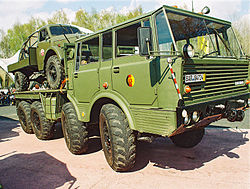National People's Army
The National People's Army (NPA; German: [Nationale Volksarmee] Error: {{Lang}}: text has italic markup (help), NVA) was the armed forces of East Germany.
The NPA was founded on 1 March 1956. It developed from the Kasernierte Volkspolizei (Barracked People's Police), which was started in 1952. Serving with the army was voluntary at first. Conscription was introduced on 24 January 1962. Conscription was for male citizens between the ages of 18 and 26. If they were selected, they had to serve in the NPA for 18 months. The NVA was at its largest in 1987. It had about 175,000 soldiers at this time.
The NVA was modeled on Soviet military philosophy. Its leadership and operations were governed by the officer corp. The non-commissioned officer corps was limited in terms of authority and responsibility, unlike in the West German army. There were also political officers throughout the NVA, whose job it was to guarantee the loyalty of the military to the ruling political party.
Organization
The NVA was made up of four main branches:
- The Landstreitkräfte (Land Forces) with a strength of 120,000 soldiers.
- The Volksmarine (People's Navy) with a strength of 16,300 sailors.
- The Luftstreitkräfte/Luftverteidigung (Air Forces/Air Defense) with a strength of 39,000 airmen.
- The Grenztruppen der DDR (Border Troops of the GDR) with a strength of 50,000 border guards.
The NVA also had a large number of reserve and paramilitary forces. These could be called to serve during a crisis.
The NVA was merged into the Bundeswehr in October 1990 upon the reunification of Germany. The merging of the two German militaries was not done equally. Many non-commissioned officers and almost all commissioned officers were not accepted into the Bundeswehr. Instead, they were discharged from service. Those who were given a place in the Bundeswehr were usually demoted by one rank. Most of the barracks were closed and much of the NVA's equipment was sold or donated to other nations.
National People's Army Media
Soldiers of the Guard Regiment Friedrich Engels marching at a changing-of-the-guard ceremony at the Neue Wache on the Unter den Linden in East Berlin
A DDR finial, here for a flag of a Ministry of the Interior (MdI) unit; the NVA had the same in gold.
The emblem of the DDR's armed forces – used for army vehicles
MiG-29 in East German service
The logo of the East German museum in Dresden. Today the Bundeswehr Military History Museum.
DDR borderguards and members of the Combat Groups of the Working Class at the border of the Berlin sector on 14 August 1961









